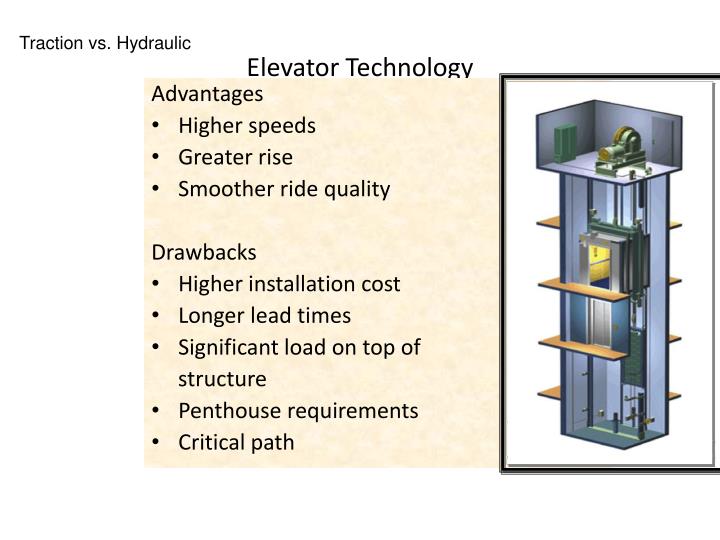Have you ever wondered about the differences between traction and hydraulic elevators? If you are about to install an elevator, especially in a high-rise building, you need to know about these two types of elevators and which one suits your requirements. Both types have their pros and cons, and it's vital to weigh them before you make your decision.
Pain Points
When it comes to selecting the right elevator for your premises, it's crucial to study the elevator's purpose and the building's structure. Firstly, determine the weight it will carry daily and how high it has to go. Secondly, the speed or frequency of use you require and whether you want a sustainable solution.
Answer
Traction and hydraulic elevators serve different purposes. Traction elevators use steel cables to move, while hydraulic elevators operate by lifting the cab using an oil-based piston. If you are looking for an elevator that reaches higher floors or travels faster than hydraulic elevators, traction elevators are the way to go. If noise and energy efficiency are more critical to you, hydraulic elevators are the better option.
Main Points
While hydraulic elevators have been in use for many years, traction elevators have recently overtaken them due to their cutting-edge technology, though the latter comes at a higher cost. Both types of elevators have pros and cons that must be carefully weighed before deciding on which one to use.
The Target of Traction Vs. Hydraulic Elevator and Personal Experience
In my experience, traction elevators have proven to be more reliable, smoother and require less maintenance. Traction elevators have many benefits over hydraulic elevators, especially for high-rise buildings. They are capable of reaching higher speeds, making them an excellent choice for skyscrapers. Traction elevators also don't require a separate machine room, making them more space-saving and energy-efficient.
The Target of Pain Points of Hydraulic Elevator and Personal Experience
Hydraulic elevators operate with an oil-based piston, making them incredibly energy-efficient and quiet when in use. With a sleek design, hydraulic elevators are an excellent choice for smaller buildings with limited space. Hydraulic elevators have less complicated control systems and cost less than traction elevators, making them a more budget-friendly option. However, they can only reach limited speeds and are best suited for shorter buildings.
Explaining Traction Vs. Hydraulic Elevator in more detail
When it comes to the actual mechanism of the elevator, hydraulic elevators operate by lifting the cab using an oil-based piston. In contrast, traction elevators utilize cables and counterweights that move the elevator up or down. Traction elevators can reach higher speeds and heights, making them ideal for skyscrapers. In contrast, hydraulic elevators are usually slower and better suited for low-rise buildings. Hydraulic elevators provide smooth rides and operate relatively quietly, making them an ideal option for residential buildings.
Explaining Traction Vs. Hydraulic Elevator in more detail
Hydraulic elevators have fewer moving parts than their traction elevator counterparts. This means they require less maintenance and are overall more reliable. However, hydraulic elevators can only reach a limited height, and they start to lose efficiency after a certain amount of floors. In contrast, traction elevators can reach higher heights and speeds, but they come at a higher construction cost. However, when it comes to performance, reliability, and long-term sustainability, traction elevators are the better choice.
Q&A on traction vs hydraulic elevator
Q1: Which kind of elevator is better for a 20-story building?
A1: Traction elevators are the better option for tall buildings with more than 20 floors due to their configuration and ability to travel faster. They can handle more traffic and offer a better experience.
Q2: How do hydraulic and traction elevators operate?
A2: Hydraulic elevators operate using an oil-based piston, while traction elevators use cables and counterweights to move the elevator up and down.
Q3: Is noise an issue with hydraulic elevators?
A3: No, hydraulic elevators run quietly because they use a hydraulic pump instead of a motor and cables.
Q4: Are traction elevators expensive to install?
A4: Yes, due to their sophisticated configuration and advanced technology, traction elevators are more expensive to install than hydraulic elevators.
Conclusion of Traction Vs. Hydraulic Elevator
In conclusion, both traction and hydraulic elevators have their pros and cons. Choosing a suitable elevator depends on various factors such as cost, travel distance, speed, and load capacity. Keeping these factors in mind, make sure to assess your requirements before making a choice. Whether you invest in a traction or hydraulic elevator, make sure to choose a suitable product that suits your needs, as this investment is for the long-term.
Gallery
Traction Vs. Hydraulic Elevators | TKE Insights June 2021

Photo Credit by: bing.com / traction elevators elevator
The Differences Between A Traction Elevator And A Hydraulic Elevator
Photo Credit by: bing.com / traction differences
Hydraulic Elevator » Pioneer Elevator Pvt Limited
Photo Credit by: bing.com /
PPT - ELEVATOR 101 PowerPoint Presentation - ID:6691201

Photo Credit by: bing.com / elevator traction hydraulic vs presentation ppt powerpoint
Traction Versus Hydraulic Lifts: Advantages And Disadvantages
Photo Credit by: bing.com / traction hydraulic advantages lift diagram lifts disadvantages versus